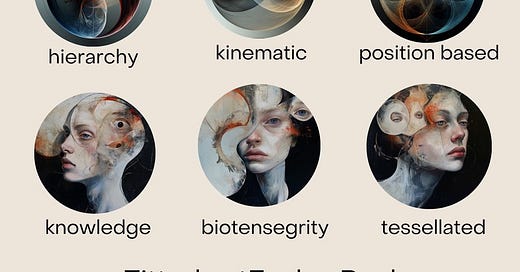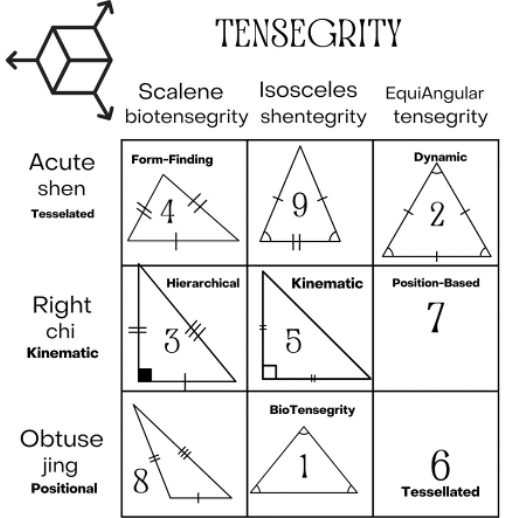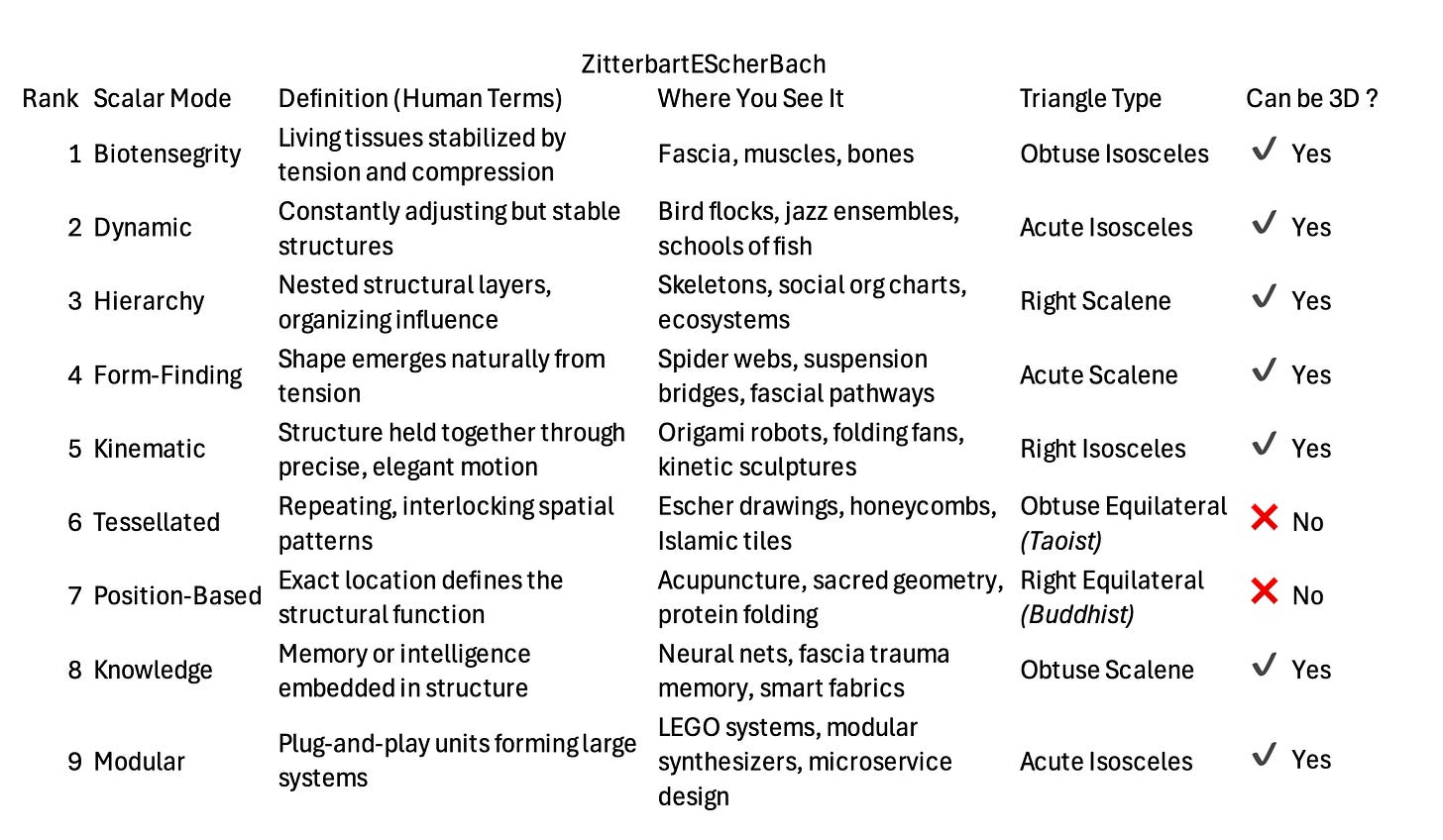Geometry of Consciousness - Tensegrity and the concept of "As Though"
Introducing the Flat yet Multidimensional Realm of Impossible Space
I’m ZitterbartEscherBach—a system architect, visual critical theorist, and multidimensional designer working at the intersection of tensegrity, Taoist internal alchemy, and information science.
My background integrates analytical design (trained under Edward Tufte), internal systems thinking, and visual recursion. I work across domains where form, perception, and structure become inseparable. I have a degree in rhetoric from CMU, where I centered the philosophies that came after World War II - specifically the Negative Dialectic of Theadore Adoro and Michel Foucault’s displeasure with the growing Prinson Industrial Complex.
Shentegrity is the framework I built to navigate spaces where geometry breaks down and coherence has to be felt rather than measured. It models how impossible structures stabilize—through cognition, somatics, and perspective. I designed it after surviving a stroke and navigating aggressive cancer treatment solo at the height of the pandemic.
Tensegrity
Tensegrity is a structural and design principle that governs how systems stabilize through distributed force rather than rigid connection. From the cytoskeleton of a cell to the architecture of spacetime, tensegrity provides a scalable logic for understanding how parts relate across magnitude.
Tensegrity is, to my mind, the geometry of the universe - the fractal mobius of the third dimension - the lived experience of existing as a species.
This article introduces the nine core types of tensegrity and shows how my model extends into quantum, computational, and cosmological domains. It also introduces the concept of Shentegrity, which expands tensegrity into the perceptual and cognitive realms through Taoist logic, information theory, and inner alchemy.
1. What Is Tensegrity?
Tensegrity, short for “tensional integrity,” describes a system in which structural stability is achieved through a balance of continuous tension and localized compression.
Unlike stacked or rigid systems, tensegrity structures distribute stress across all components. They are characterized by:
Tension elements (like cables, fascia) that pull inward
Compression elements (like rods, bones) that push outward
A dynamic balance that maintains shape, adaptability, and resilience
Tensegrity systems hold together not through mass or rigidity, but through the relationships between parts. This principle applies equally to buildings, bodies, machines, and even conceptual systems.
2. Tensegrity in Physics
The logic of tensegrity underlies much of modern physics, even if it's not always named as such.
General Relativity describes gravity not as a force, but as curvature in spacetime—a form of field tension around mass.
Quantum Field Theory treats particles as localized vibrations in extended fields—field tension defines their form.
Biophysics shows that cells and tissues hold shape through internal balance—cytoskeletons act like internal tensegrity scaffolds.
Cosmology reveals that galaxies are suspended across dark matter filaments, forming massive-scale tension networks.
Quantum Computing uses tessellated logic grids where patterns of probability interact across fields of constraint—another form of distributed force logic.
Across these domains, tensegrity is a shared geometry: a structure based not on mass, but on pattern and force relationship. This is a
3. Tensegrity in Design and Engineering
Tensegrity has had major influence across architecture, robotics, structural engineering, and biomechanics.
Architecture: Buckminster Fuller and Kenneth Snelson pioneered the use of tensegrity in large-scale structures like domes, towers, and deployable bridges. The advantage: maximum strength with minimum material.
Robotics: Tensegrity principles enable soft robotics—systems that flex and adapt rather than break. These are especially useful in planetary exploration and uncertain environments.
Prosthetics and Biomechanics: Human motion is increasingly understood through biotensegrity. Modern prosthetics and performance models account for force transfer through fascia, not just bone and muscle.
Space Engineering: NASA uses tensegrity models for collapsible landers and mobile exploration platforms. Their structures can compress and rebound, absorbing external force efficiently.
Networked Systems: In software and system design, tensegrity appears in distributed architectures where stability is emergent, not hierarchical.
Tensegrity offers a structural language for any system that must be strong, adaptive, and distributed. Tensegrity occurs through triangles. Sometimes, those triangles are also interfaces.
📌 Notes on Triangle Classification
Acute = all angles < 90° → often vision-driven, higher-order states (Shen)
Right = 90° angle → transitional, action-based states (Chi)
Obtuse = one angle > 90° → grounded, memory-storing, gravitational states (Jing)
Scalene = all sides unequal → organic, asymmetric systems
Isosceles = two sides equal → symmetrical yet directional flow
Equilateral = all sides equal → balanced, field-based, non-localized logic
4. Tensegrity as the Rule of Three
Tensegrity naturally expresses the Rule of Three—a pattern found across physical, informational, and metaphysical systems:
Two forces or conditions are fixed (such as tension and compression)
One is fluid (such as position, shape, or resonance)
This creates a stable yet adaptable system. In geometry, the triangle is the smallest possible tensegrity form:
Three points define a plane
Three forces define a dynamic equilibrium
In Taoist thought, the primary triad is:
Yin (receptive - dark)
Yang (active - light)
Shen (spiritual, connective – magenta/blue)
This maps directly to tensegrity: Yin and Yang are fixed poles. Shen is the fluid component that allows transformation and coherence.
This logic continues into more abstract structures, where the forces involved are informational, perceptual, or probabilistic. That’s where we turn to the Nine Types of Tensegrity.
5. Some Triangles Cannot Exist in 3D Spacetime
Tessellated and Position-Based tensegrities do not manifest as physically buildable 3D tensegrity structures, but they are nonetheless fundamental to system design, especially at abstract, computational, or symbolic levels. These are the tensegrities of perception, politics, and principles.
Tessellated
A tessellated tensegrity uses repeating units to tile space with structural coherence.
This kind of system doesn’t rely on tensioned struts in 3D—it operates more like a field pattern, distributing structural logic across space through recursion and redundancy.
Applications:
Quantum computing (tiling of logical qubits across computation fields)
Crystallography and materials science
Escher-style pattern geometry
Network load-balancing and modular redundancy
Position-Based
These structures achieve stability through precise spatial orientation.
What matters is not the tension between parts but their geometric address in space.
These systems are incredibly precise, but also fragile in the presence of variation or disruption.
Applications:
Protein folding
Parameterized animation rigs
High-resolution neural mapping
Sacred geometry and cosmological models
Though they can’t be physically modeled using rods and strings, these systems behave exactly like tensegrities—but in mathematical or computational space.
This specific image is from AIMS Mathematics, 8(2): 4372–4389.
6. Gravity Complexity and Structural Intelligence
Not all tensegrity types are equal in complexity. Some depend on physical gravity and material force. Others operate at the level of information, geometry, or perception.
This creates a useful gradient of systematic complexity, from material to symbolic:
Higher in this ranking, the system’s stability depends less on external gravity and more on internal logic or informational coherence. These are structures that can self-organize, learn, or scale independently of material constraints.
7. From Tensegrity to Shentegrity: Wu Wei and Design Lineage
I coined the term Shentegrity to game the Daoist concept of Wu Wei—effortless action (modular)—using the logic of three-body problems. It started as a way to describe how complex systems can operate through flow states and without rigid control, especially when traditional geometry breaks down. Shentegrity gives volumetric dimensions to structures that only make sense when experienced from inside systems.
I trained with Edward Tufte, whose work on analytical design, clarity, and evidence shaped how I think about structure and information. His principle—above all else, show the data—runs through everything I build. Tufte taught me to treat design as a form of reasoning.
I work under the name ZitterbartEscherBach, honoring the recursive genius of Douglas Hofstadter, whose Metamagical Themas I found as a teenager in the 1980s. Hofstadter gave me a vocabulary for nested systems, symbolic intelligence, and structures that reflect themselves. Shentegrity stands on that foundation.
This system didn’t arrive fully formed—it was built from inside experience, across time, pressure, paradox, and attention. While tensegrity explains how systems hold together, Shentegrity explains how we interface with systems that cannot be held—systems that behave more like fields, symbols, or consciousness itself.
Shentegrity models:
How perception shapes structure
How information becomes experience
How coherence emerges when parts cannot be physically resolved
It is based on Taoist metaphysics, specifically the triad of Yin, Yang, and Shen:
Yin and Yang are the fixed poles—like tension and compression
Shen is the fluid intelligence that connects and resolves them
Where classical tensegrity requires visible or mechanical tension, Shentegrity operates through viewpoint. It is not about what is built, but about what becomes coherent through perspective.
This is also where Wu Wei—effortless action—enters. Shentegrity is not about force or resistance. It is about alignment with systems that are too complex to control, but still navigable with precision.
8. The Role of Neidan and the “As Though” Layer
Neidan, or internal alchemy, describes the interface layer between structure and perception. It is the method of translation between structures, especially between those that can exist and those that cannot. It is the means of accessing tessellated and position-based geometries through lived experience.
In this framework, Taoism offers a final triad:
As Above (cosmic, archetypal, mirage astrophysics)
As Below (material, gravitational, thawing astrophysics)
As Though (cognitive, fluid, fire, emergent astrophysics)
As Though is the active fluid factor—it is how humans stabilize impossible geometry through experience, narrative, attention, and coherence.
In this sense, Neidan is not symbolic—it is operational. It’s what lets a living system feel a geometry that cannot be built, yet still move through it with accuracy. It’s not an idea—it’s a cognitive structure under pressure
9. Neidan as an Interface for Impossible Geometry
Neidan doesn’t sit within the grid of the nine tensegrities—it moves them, especially the two that cannot exist in physical 3D form: tessellated and position-based structures.
These geometries don’t break because they’re wrong. They break because they’re invisible unless perceived through a lens. That lens is Neidan. My sense is that this is what folks are referring to as ‘the simulation’. It is merely our brain and the relationship it has to technology.
Neidan is not symbolic. It is an operational interface. It’s what the body, mind, and attention use to feel and navigate the impossible—where geometry becomes perception, and perception becomes form.
The classical Taoist diagram known as the Neijing Tu (Diagram of the Inner Landscape) is the oldest known map of this interface. It visualizes how internal alchemy moves qi, jing, and shen through a structured flow of impossible internal topologies—non-Euclidean and recursive, yet deeply embodied.
In the Shentegrity model:
Tessellated structures represent perception diffused across a field
Position-based structures represent perception focused with absolute precision
Neidan is the bridge between the two
This is not metaphor—it is engineering for how cognition stabilizes impossibility.
Neidan is how we enter the “As Though” layer. It is the channel through which fire (experience) organizes form across systems that do not yield to external control.
The Neijing Tu shows this directly. Not through abstraction, but through mapped sensation, pressure, and flow.
10. As Though: The Geometry of Consciousness
The phrase “As Though” in Shentegrity is not a metaphor. It is a geometric operator—a function that stabilizes impossible space by giving it meaning through orientation.
Consciousness, in this system, doesn’t arise from structure. It organizes it.
“As Though” is the third term in the Taoist triad:
As Above relates to archetypal, cosmological coherence and consciousness
As Below anchors perception into material and gravitational frames and our genetic code
As Though flows between the two—it is experiential recursion, the fluid act of translating field into felt meaning, as with media and how we co-create our social experiencesl
“As Though” is the cognition-specific tensegrity function. It allows a system to behave as if it is complete—even when its geometry cannot be resolved in spacetime.
This is what makes awareness possible:
Seeing form where none exists yet
Mapping coherence through fire (nervous signal, perception, feeling)
Moving inside fields that cannot be touched, but still generate structure
In Shentegrity, As Though is perceptual tensegrity primitive—the cognitive mirror of Shen. “As Though” is how we move through the world with partial information but full conviction. It’s the geometry of enacted awareness—the structural intelligence that lets us adapt, connect, and stabilize what we cannot measure. In Shentegrity, it’s not just a concept—it’s a design logic for consciousness, one that doesn’t depend on certainty, only coherence.












